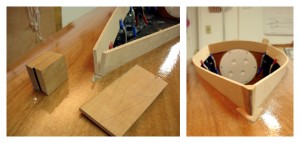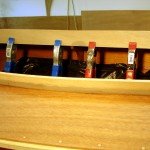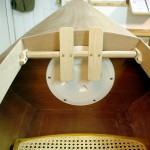Some time ago, I showed some “small stuff” that was done while waiting for epoxy to cure.

 That work was creating and dry fitting the coaming parts. I needed to turn the boat over again to finish painting the bottom, so held of on installing those parts. Back to them now. It seems an simple job: epoxy them in place, clean up the excess, and move on. So simple …
That work was creating and dry fitting the coaming parts. I needed to turn the boat over again to finish painting the bottom, so held of on installing those parts. Back to them now. It seems an simple job: epoxy them in place, clean up the excess, and move on. So simple …
Unless of course, you botch it. My mistake was cleaning up with some contaminated white vinegar. I had degunked a cabinet rasp in the jug of white vinegar. That discolored the vinegar mildly, but not enough to set off warning alarms the next time I picked up the jug. The contamination settled out as gray stains on the freshly installed coaming. Of course, it wasn’t immediately visible. The next day brought out the dreaded sandpaper and (with tedium) the stain was removed. You can still find remnants if you know where to look.
 Work with the backrest went much better. The rest itself was assembled some time ago. Now with the actual width defined by the completed coaming, the job was to make the blocks, trim the crossbar to fit, reshape some for pleasing appearance and dry fit it in place. Then, of course, remove it so the coaming, and the deck can receive a few coats of Marine Cetol as the finish that provides UV protection for the epoxy.
Work with the backrest went much better. The rest itself was assembled some time ago. Now with the actual width defined by the completed coaming, the job was to make the blocks, trim the crossbar to fit, reshape some for pleasing appearance and dry fit it in place. Then, of course, remove it so the coaming, and the deck can receive a few coats of Marine Cetol as the finish that provides UV protection for the epoxy.
That last finishing is underway now. Pictures later.
FWIW, Sikkens advises re-coating Cetol after 24 hours, and NO sanding between coats. They do that (1) because the stuff isn’t cured enough for sanding after 24 hours (or 48, or 72 (dahik)), and (2) they want to be sure you apply a full 3 coats, not 3 diminished coats, to get the protection they guarantee.
Bob,
It is obvious I don’t know where to look – but everything is looking GREAT! When do you anticipate launch day? What a wonderful photo that will be, with two boats going in the water at once.
Al